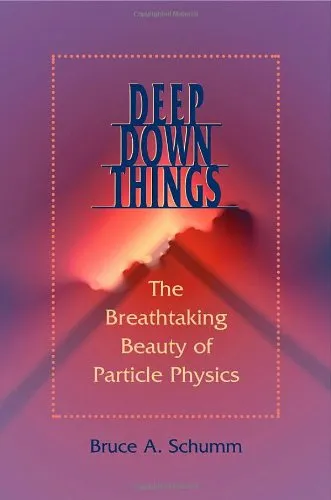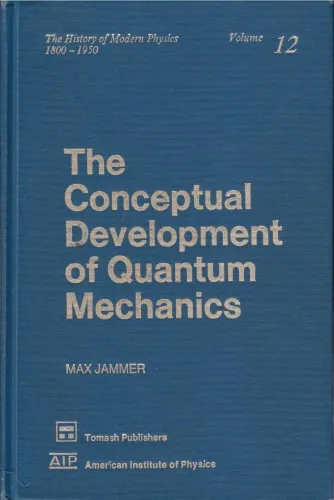The structure of scientific revolutions
4.5
بر اساس نظر کاربران

شما میتونید سوالاتتون در باره کتاب رو از هوش مصنوعیش بعد از ورود بپرسید
هر دانلود یا پرسش از هوش مصنوعی 2 امتیاز لازم دارد، برای بدست آوردن امتیاز رایگان، به صفحه ی راهنمای امتیازات سر بزنید و یک سری کار ارزشمند انجام بدینکتاب های مرتبط:
معرفی کتاب "The Structure of Scientific Revolutions"
کتاب "The Structure of Scientific Revolutions" نوشته توماس س. کوهن، یکی از تاثیرگذارترین آثار در فلسفه علم در قرن بیستم محسوب میشود. این کتاب که نخستین بار در سال ۱۹۶۲ منتشر شد، برداشت جدیدی از روند پیشرفت علم و تغییرات علمی ارائه میدهد.
خلاصهای جامع از کتاب
توماس س. کوهن در این اثر برجسته خود، روند تکامل علم را از دیدگاهی ساختاری تحلیل میکند. او بیان میدارد که علم در قالب یک روند خطی و انباشتی پیشرفت نمیکند، بلکه از طریق سلسلهای از انقلابات علمی (Paradigm Shifts) تحول مییابد. هر Paradigm به عنوان چارچوبی برای تحقیقات علمی عمل میکند و زمانی که دیگر قادر به حل مسائل و تناقضات ناشی از کشفیات جدید نیست، نیاز به یک Paradigm جدید پدید میآید.
کوهن با تحلیل تاریخی تغییرات علمی، مراحل مختلفی را برای یک انقلاب علمی مشخص میکند؛ از جمله زمان عادی (Normal Science)، بحران (Crisis) و انقلاب (Revolution). او معتقد است که در حالت عادی، دانشمندان عمدتاً بر روی پازلهایی کار میکنند که Paradigm جاری تعیین میکند، اما با ظهور دادههای ناسازگار یا ناهنجاریها، زمینه برای تغییر Paradigm فراهم میشود.
نکات کلیدی کتاب
- Paradigm Shifts به عنوان محرکهای اصلی تغییرات علمی، نقشی اساسی در فهم ما از علم ایفا میکنند.
- روند علمی از طریق انباشتی پیش نمیرود بلکه با عبور از Paradigm های متفاوت و تحول انقلابی قابل توضیح است.
- تاریخ علم نشان میدهد که نظریات و Paradigms علمی باید توانایی پاسخگویی به ناهنجاریها و دادههای جدید را داشته باشند، تا به بقای خود ادامه دهند.
نقلقولهای معروف از کتاب
"Paradigm Shifts به طور معمول با تغییرات بنیادی در نگرشها و باورهای دانشمندان همراه است."
"علم در دورههای عادی با برنامهریزی و آرامش پیش میرود، اما در دورههای بحران، علم رو به آشفتگی میآورد."
چرا این کتاب اهمیت دارد
کتاب "The Structure of Scientific Revolutions" تحولی در فهم ما از تاریخ و فلسفه علم ایجاد کرده است. کوهن با ارائه دیدگاه جدیدی نسبت به پیشرفت علم، مسیر حل مسائل نظری متعددی را باز کرد. این کتاب نه تنها برای فلسفهدانان علم، بلکه برای هر کسی که به موضوعات علمی و تغییرات بنیادی در علم علاقهمند است، اهمیت بالایی دارد. کوهن از طریق توضیح منظم و متناوب Paradigm Shifts به ما نشان میدهد که چگونه فهم ما از جهان میتواند به واسطه انقلابات علمی تحول یابد.
The Structure of Scientific Revolutions: An Introduction
Thomas S. Kuhn’s groundbreaking work, "The Structure of Scientific Revolutions", challenged the prevailing conception of scientific progress. Originally published in 1962, the book redefined how we perceive the evolution of science itself. This text remains a foundational piece in the philosophy of science, known for introducing the concept of "paradigm shifts" as a key mechanism in the advancement of science. Here, we delve into a detailed introduction to this influential work.
Detailed Summary of the Book
The book is structured around the cycle of scientific development, proposing that scientific progress is not a linear accumulation of knowledge, but rather a series of revolutionary changes. Kuhn identifies phases including normal science, crisis, and the revolutionary shift in paradigms. During the 'normal science' phase, scientists work within an established framework or paradigm, solving puzzles without questioning the framework itself.
However, when anomalies arise that the current paradigm cannot explain, science enters a crisis stage, eventually leading to a paradigm shift. A 'scientific revolution' occurs when the framework is replaced by a new paradigm, which offers better explanations for the anomalies. This new paradigm, through its own normal science phase, continues until it later encounters unresolvable anomalies, perpetuating the cycle.
Key Takeaways
- Paradigm shifts are central to scientific progress.
- Scientific revolutions are non-cumulative and require rethinking past data within a new framework.
- The perception of scientific facts is influenced by the scientist’s cultural context and theoretical framework.
- Progress in science involves both rigorous adherence to existing paradigms and radical shifts when those paradigms can no longer accommodate emerging anomalies.
- Anomalies are a crucial aspect of scientific inquiry, as they challenge existing paradigms and instigate revolutions.
Famous Quotes from the Book
"The historian of science may be tempted to exclaim that when paradigms change, the world itself changes with them."
"Normal science does not aim at novelties of fact or theory and, when successful, finds none."
Why This Book Matters
Kuhn's work fundamentally altered the way we understand scientific advancement. By challenging the notion that science progresses solely through steady accumulation of knowledge, Kuhn illuminated the complex and often tumultuous nature of scientific progress. His concept of paradigms and their revolutionary shifts offered a framework for understanding the dynamic and transformative processes that have historically driven scientific inquiry.
Moreover, "The Structure of Scientific Revolutions" transcended scientific realms, influencing disciplines as varied as sociology, political science, and education. The implications of the book extend to understanding not just science, but the processes of learning, change, and development that permeate human pursuits and institutions.
For scholars and practitioners in the field of science and beyond, Kuhn’s insights provide a profound reflection on the nature of change and the evolution of knowledge itself. This work remains essential reading for anyone interested in the philosophy of science, the history of science, or the processes underlying intellectual advancements in any field.
دانلود رایگان مستقیم
شما میتونید سوالاتتون در باره کتاب رو از هوش مصنوعیش بعد از ورود بپرسید
دسترسی به کتابها از طریق پلتفرمهای قانونی و کتابخانههای عمومی نه تنها از حقوق نویسندگان و ناشران حمایت میکند، بلکه به پایداری فرهنگ کتابخوانی نیز کمک میرساند. پیش از دانلود، لحظهای به بررسی این گزینهها فکر کنید.
این کتاب رو در پلتفرم های دیگه ببینید
WorldCat به شما کمک میکنه تا کتاب ها رو در کتابخانه های سراسر دنیا پیدا کنید
امتیازها، نظرات تخصصی و صحبت ها درباره کتاب را در Goodreads ببینید
کتابهای کمیاب یا دست دوم را در AbeBooks پیدا کنید و بخرید
1611
بازدید4.5
امتیاز0
نظر98%
رضایتنظرات:
4.5
بر اساس 0 نظر کاربران
Questions & Answers
Ask questions about this book or help others by answering
No questions yet. Be the first to ask!















